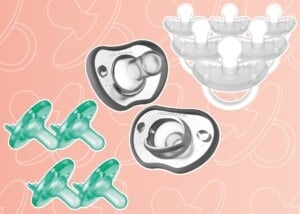You did it! You conquered labor and delivery. That was no easy feat, mama; pat yourself on the back. What’s next, you may be thinking? Your precious little one is in your arms, and it’s officially go-time. It’s time to feed them and learn how to make your milk come in faster.
Throughout your pregnancy, your body prepares for your baby to be born. Your baby is now here, and the good news is that your body is ready and equipped to feed them. You will learn to navigate the breastfeeding journey together; you are the perfect pair. Little by little, you will start gaining more confidence and find what works best for you and your little one. Now it’s time for your breastfeeding journey to begin.
When Will My Milk Come In?
As a new mom, you may worry about when your milk is coming in, if you can make it come in faster, and if your baby is getting enough. The process of a mother’s milk production is genuinely incredible. Many hormones play an essential role in the production of breast milk. Throughout pregnancy, your progesterone levels are high. These levels are necessary to maintain pregnancy. Once your baby is born, progesterone levels start to decrease. This makes your body aware that it is time to transition from pregnancy to lactation.1
During the initial days, your baby will receive its first milk, called colostrum. Colostrum is nutrient-packed and provides everything your baby needs for the first few days of life. When you see colostrum, you may question, why is it this color, why is it so thick, is this normal? YES! The thickness and color come from colostrum’s unique nutritional properties. Colostrum is highly beneficial to your baby, especially with its infection-fighting properties and nutritional components.3
Your colostrum will change to your full milk supply in the following days. Anywhere from day 2 to day 8 (average 3-5) postpartum, you will notice your breasts becoming fuller. This means your milk is starting to “come in” and you will start producing a higher volume.1 Let’s dive into ways you can help your early milk supply come in faster.
5 Tips To Make Your Milk Come In Faster
When your body is ready to feed your baby, there are a few tips to help support early milk production and make milk come in faster:
1. Skin-to-Skin Contact
Skin-to-skin is a straightforward concept that can play a valuable role in the start of your breastfeeding journey. This means your baby is lying with you, bare skin touching. When your baby is placed on your chest after birth, the bonding immediately begins. Baby knows your smell and, if given the opportunity, can even make their way to your breast for the first feed on their own. Amazing, right? Not only is skin-to-skin beneficial for breastfeeding initiation, but it also can help regulate a baby’s body temperature, stabilize blood sugars, and reduce infant stress.1,2
2. The Golden Hour Feed
The first hour after birth is considered the “golden hour.”2 This refers to the importance of your baby breastfeeding for the first time during this period.2 Babies are usually very alert during the first two hours of life, making this a perfect opportunity for your baby to feed.1
Here’s why the “golden hour” feed is so important:1,2
- Your baby will quickly receive colostrum, benefiting from its nutritional and protective components.
- Your baby is born with a suckling reflex. This reflex is usually strong right after birth. Giving your baby the early gratification of using this suckling reflex helps “imprint” this behavior, allowing them to learn how to suck and feed. This sets your baby up for a successful breastfeeding journey.
- Your baby will remove milk from your breasts, showing your body that more milk is needed to trigger the production process.
3. Bringing Baby to Breast Often
During the early weeks, it is crucial to your milk supply that your breasts are stimulated and milk is removed. Removing milk helps notify your body how much is needed and is necessary to ensure an abundant milk supply in the coming weeks to support your baby’s growing needs. Simply put, it is supply and demand.1,4
For exclusively breastfed babies, it is recommended that they feed eight or more times in 24 hours.1,4 Your baby will offer feeding cues to help you know they are hungry and ready to feed. Some cues you may see include mouth movements, restlessness, hands to mouth, tense body and mouth, and crying. Try to recognize that your baby is hungry before they start to cry because this is a late cue.4 When you identify their cues, get ready to put your baby to the breast to feed.
Here are some quick feeding tips:
- Feed on demand; when your baby is showing they are ready to eat.
- Rotate which breast you offer your baby first.1 A helpful way to remember is to wear a hair tie on your wrist and rotate it after each feeding. That way, the wrist with the hair tie is the side you will start your next feed on.
- Let your baby feed as long as they desire. Don’t time each meal; let baby show you cues they are finished.1
- Offer your second breast after they finish with the first. They might refuse the other side but offer to ensure they are finished.1
- Feedings are still necessary during the night, especially in the beginning. You may need to wake your baby to feed them.1
4. A Good Latch
Ensuring your baby is latching correctly can set you and your baby up for breastfeeding success. A good latch is “the ability of the infant to grasp the nipple, flange the upper and lower lips outward against the breast areola, and remain firmly on the breast between bursts of suckling.”1 It is a good idea to ask for support from the hospital or birthing center lactation team. They can assess your baby’s latch, show you different breastfeeding positions to find what works best for you, and offer support to help you feel more confident.1
The benefits of a good latch include:
- Baby can effectively remove milk from mom’s breasts, helping maintain mom’s milk supply.1
- Helps baby return to birth weight.1
- Decreases the risk of nipple pain and trauma. Nipple pain is a top cause of moms deciding to stop breastfeeding.2
5. Nutrition and Sleep
Nutrition is essential while breastfeeding. Breastfeeding is hard work, and your body will require an increase in calories.5 Eating a well-balanced diet full of healthy choices helps nourish your body. As a busy mom, it might be hard to remember to stop and take a drink but remember to keep sipping your water; hydration is always a good thing.6 This is also a time to note that caffeine can pass through breast milk to your baby. Although you may feel like you need constant caffeine, drink in moderation.5
As new parents, sleep is sacred, and we know it can be hard to come by the first few weeks you bring your baby home. Research has shown that the composition of breast milk changes with a mom’s circadian rhythms. Different levels peak at different times of the day. At night, the hormone prolactin (which plays a crucial role in milk production) is higher than levels during the day.1 This means more milk is available to your baby at night. Therefore, you may see your baby feeding for more extended periods at night. Melatonin is another factor found in breast milk at night. This helps your baby start to form sleeping patterns. It has even been shown that breastfed babies sleep an average of 45 minutes longer each night than formula-fed babies.7
What Can Cause My Milk To Decrease?
If you feel like your milk supply has decreased, it may be because:
- Baby is feeding less than eight to 12 times a day.1
- Baby is not latching correctly, causing inadequate pull of milk.1
- Supplementing with bottles after nursing.8
- Using the wrong breast pump flange size when pumping.8
- Maternal separation from baby.1
If you notice an unexpected decrease in your supply, it is essential to reach out to a lactation consultant or medical team member. They can help create a plan to assist in bringing your supply back up.
These helpful tips can be a great way to start your breastfeeding journey on a positive note. Learning what works best for you and your baby may take time. But you are the perfect pair, even if you encounter some challenges the first few days after birth. Please do not feel alone if breastfeeding is not as easy as you anticipated. Every baby and mother is unique in their way. Please reach out for help to your lactation and health care teams. They are always there to support you and guide you through challenging times. You got this, mama!











